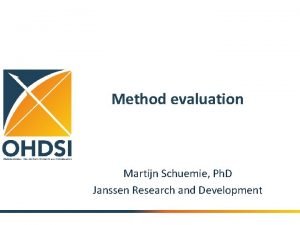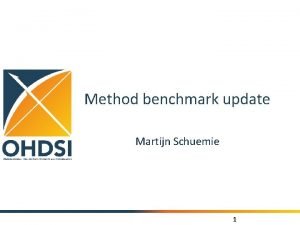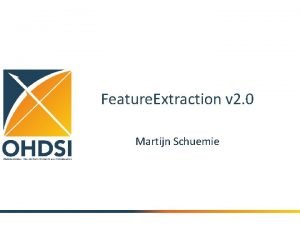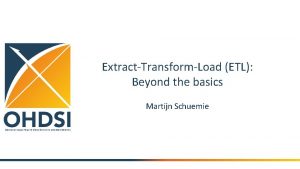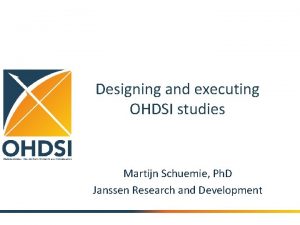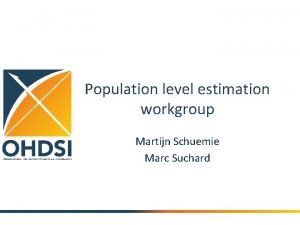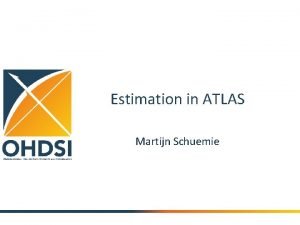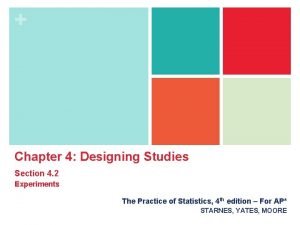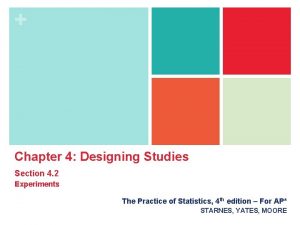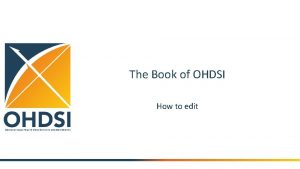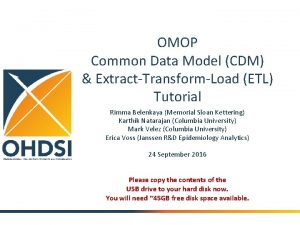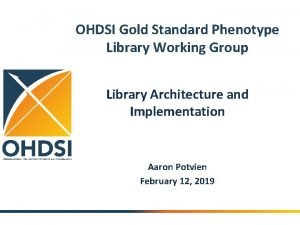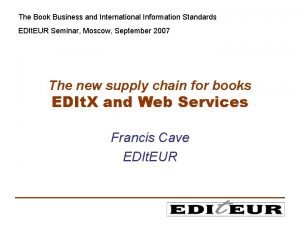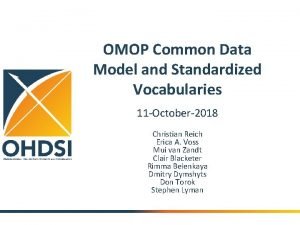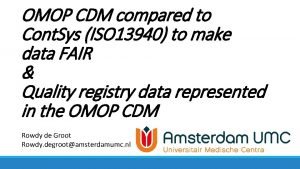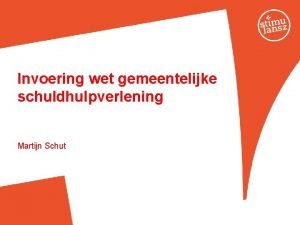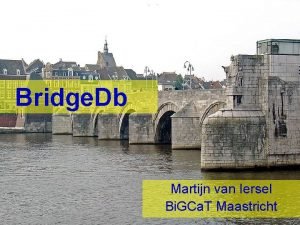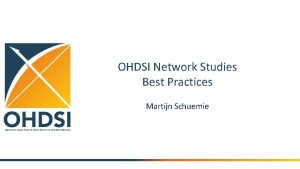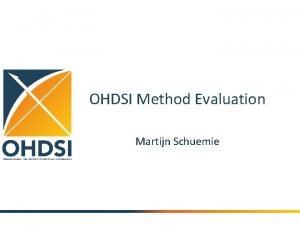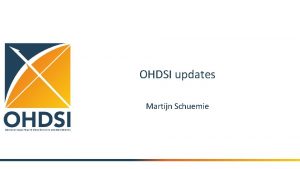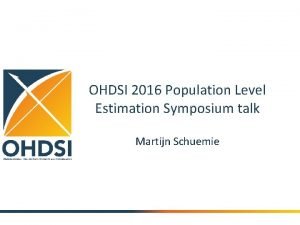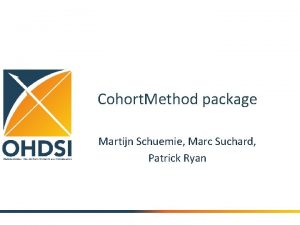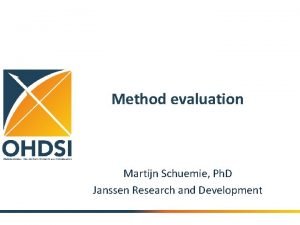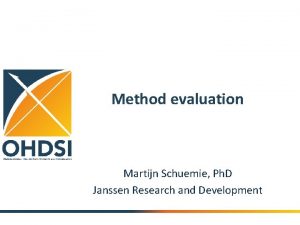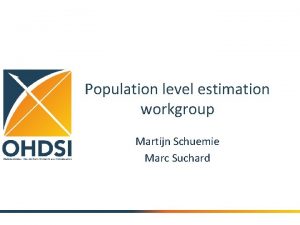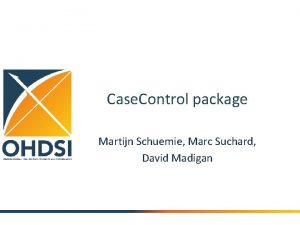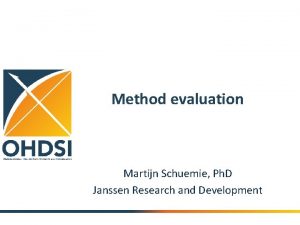Designing and executing OHDSI studies Martijn Schuemie Ph

























- Slides: 25

Designing and executing OHDSI studies Martijn Schuemie, Ph. D Janssen Research and Development

OHDSI Study Concern about increased risk of angioedema during Keppra (levetiracetam) exposure. Study comparing levetiracetam to phenytoin for the risk of angioedema. 2

Target cohort 3

Comparator cohort 4

Outcome cohort 5

Model + time at risk • Cox proportional hazards model • Variable-ratio matching on propensity score Two time at risk definitions: • Per-protocol: start of exposure to end of exposure (max 30 day gap) • Intent-to-treat: Start of exposure to end of observation 6

Negative controls! • 100 outcomes not believed to be caused by levetiracetam to phenytoin. 7

Study R package T, C, and O definitions Negative controls Model selection Standard reports Result sharing Time at risk definition CDM 8

Keppra-angioedema study Stanford Columbia University IMS Regenstrief University of Texas Janssen 9

Diagnostics (CCAE at Janssen) 10

Negative controls (CCAE at Janssen) Per-protocol Intent-to-treat 11

Results 12

Intent-to-treat Per-protocol Meta-analysis for random FX I 2 = 0 13

Paper • Paper was submitted to Epilepsia • Excellent reviews • Will be resubmitted this week 14

Levetiracetam study: the good and the bad Good: • All OHDSI tools came together to make this easy • Negative controls showed little residual bias • Study was executed across network of diverse partners Bad: • Humans are the weakest link in terms of time-tocompletion ; -) • Little insight into how cohort definitions worked at each site • Need a predefined approach to combining results 15

Save Our Sisyphus Challenge T: Alendronate C: Raloxifene O: Hip fracture, vertebral fractures, atypical femoral fractures, osteonecrosis of the jar, and esophageal cancer Model: Cox using PS stratification Time-at-risk: Intent-to-treat and per-protocol (both excluding first 90 days) Negative controls: 147 outcomes 16

Save Our Sisyphus Challenge Week 1. Write protocol Week 2. Write and test study package Week 3. Run study across network Week 4. Analyze results and write paper 17

Discussion • OHDSI is developing a standardized approach to answering a certain type of questions • Becoming more and more efficient • Question-driven or large-scale evidence generation? 18

Questions about study design “exclude subjects from T and C who have the outcome in the 90 days after index” • Immortal time bias? 19

Removing subject with event in first 90 days library(survival) n <- 1000000 baseline. Rate <- runif(n, 0. 0001, 0. 001) rr <- 2 treatment <- round((1: n)/n) rate <- baseline. Rate * (1 + (rr-1) * treatment) time. To. Event <- rexp(n, rate) time <- time. To. Event time[time > 365] <- 365 event <- time. To. Event < 365 strata <- cut(baseline. Rate, breaks = quantile(baseline. Rate, (0: 5)/5), labels = 1: 5) data <- data. frame(start = 0, time = time, event = event, treatment = treatment, strata = strata) fit <- coxph(Surv(time = time, event = event, type = "right") ~ treatment + strata(strata), data) exp(coef(fit)) # 1. 998335 # Remove subjects with event in first 90 days --------------data. Prime <- data[data$time > 90, ] fit <- coxph(Surv(time = time, event = event, type = "right") ~ treatment + strata(strata), data. Prime) exp(coef(fit)) # 1. 994191 # Remove subjects with event in first 90 days, reset index date------data. Prime <- data[data$time > 90, ] data. Prime$time <- data. Prime$time - 90 fit <- coxph(Surv(time = time, event = event, type = "right") ~ treatment + strata(strata), data. Prime) exp(coef(fit)) # 1. 994191 20

Questions about study design “restrict the analysis to subjects with at least 365 days of exposure” • Are we sure the outcome does not affect subsequent exposure? Wat about if the outcome can be lethal? • Probabilistic immortal time bias? 21

Removing half of subjects with the outcome library(survival) n <- 1000000 baseline. Rate <- runif(n, 0. 0001, 0. 001) rr <- 2 treatment <- round((1: n)/n) rate <- baseline. Rate * (1 + (rr-1) * treatment) time. To. Event <- rexp(n, rate) time <- time. To. Event time[time > 365] <- 365 event <- time. To. Event < 365 strata <- cut(baseline. Rate, breaks = quantile(baseline. Rate, (0: 5)/5), labels = 1: 5) data <- data. frame(start = 0, time = time, event = event, treatment = treatment, strata = strata) fit <- coxph(Surv(time = time, event = event, type = "right") ~ treatment + strata(strata), data) exp(coef(fit)) # 1. 998335 # Having event increases probability of being removed ----------data. Prime <- data[data$event == 0 | (runif(n) < 0. 5), ] fit <- coxph(Surv(time = time, event = event, type = "right") ~ treatment + strata(strata), data. Prime) exp(coef(fit)) # 2. 118383 22

Conclusions • OHDSI tools make performing a study easier • It is still possible to design a bad study 23

Topics for next meeting? 24

Next workgroup meeting Eastern hemisphere: May 3 • 3 pm Hong Kong / Taiwan • 4 pm South Korea • 4: 30 pm Adelaide • 9 am Central European time • 8 am UK time Western hemisphere: April 27 • 6 pm Central European time • 12 pm New York • 9 am Los Angeles / Stanford http: //www. ohdsi. org/web/wiki/doku. php? id=projects: workgroups: est-methods
 Martijn schuemie
Martijn schuemie Benchmark
Benchmark Martijn schuemie
Martijn schuemie Martijn schuemie
Martijn schuemie Martijn schuemie
Martijn schuemie Marc suchard
Marc suchard Ohdsi atlas demo
Ohdsi atlas demo Chapter 4 designing studies
Chapter 4 designing studies Chapter 4 designing studies
Chapter 4 designing studies Process of crafting and executing strategy
Process of crafting and executing strategy The book of ohdsi
The book of ohdsi Omop etl
Omop etl Ohdsi phenotype library
Ohdsi phenotype library Book of ohdsi
Book of ohdsi Omop common data model
Omop common data model Iso 13940
Iso 13940 Classical plating uses this object to model the plating
Classical plating uses this object to model the plating Chapter 5 managing risk with the ipde process
Chapter 5 managing risk with the ipde process Paradigm shift from women studies to gender studies
Paradigm shift from women studies to gender studies Martijn schut
Martijn schut Martijn nolen
Martijn nolen Martijn weesing
Martijn weesing Martijn van de voort
Martijn van de voort Martijn priem
Martijn priem Martijn van iersel
Martijn van iersel Martijn van breden
Martijn van breden
